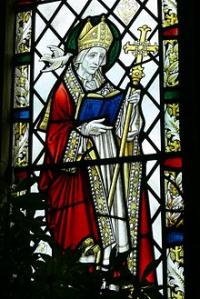
St David (c500 - 589)
Feast day: 1 March
Dewi Sant or St David is the only home-grown patron saint in these islands. St George and St Andrew came from what is modern Turkey and Palestine respectively, and Patrick was a Roman Briton coming from either the Strathclyde area in Scotland or indeed from near what is now St David’s. In fact in the late 11th century "the Life of St David" (Buchedd Dewi) by Rhygyfarch, the writer claims that St Patrick had originally wanted to work in Wales but was told in a dream that this mission would be left to someone who would come after him and that his destiny was Ireland. It’s a good story. Modern scholars feel that some of the information in Buchedd Dewi is unreliable. He has been described as a "spin doctor" and some of the reputed miracles of Dewi Sant were used as propoganda to promote the independence of the Welsh church that resisted the Roman rite until the 8th century and wanted equal status with Canterbury. This may account for the tradition that St David was supposedly consecrated by the metropolitan of Jerusalem.
There are a few facts about David which are undisputed. His mother was St Non. The legend tells us that his father was King Sant of South Wales. His teacher was St Paulinus of Wales. St David was a monk bishop. He founded many monasteries in Wales, Dunmonia (now the west country of England) and Brittany; thus he brought Christianity to much of Celtic west Britain and even the continent. There is some suggestion that he founded Glastonbury Abbey; in any event he may have visited there. He became Archbishop of Wales, although he always remained in his community at Menevia, now St David’s, which is in the valley of Glyn Rosyn, Pembrokeshire. Menevia was recently reconstituted as a diocese comprising south west and mid Wales. However its cathedral is now in Swansea.
David had a reputation for asceticism. His rule prescribed that the monks had to pull the plough themselves without draught animals, must drink only water and eat only bread with herbs and salt. Evenings were to be spent in prayer, reading and writing. David in fact was called Dewi Ddyyfrwr as he only drank water. His most famous miracle is said to have taken place when he was preaching to a large crowd at the Synod of Brefi. The village of Llandewi Brefi stands on the spot, where the ground on which he stood is reputed to have risen to form a small hill. A white dove, which became his emblem, was seen sitting on his shoulder.
It is said that David lived to over a hundred years old. He was buried at St David’s cathedral. His shrine became a popular place of pilgrimage and there was a saying: "Twice to St David’s equals once to Rome or thrice to St David’s equals once to Jerusalem."
St David is supposed to be associated with corpse candles, lights that would warn of the imminent death of a member of the community. St David wanted people to have warning of their coming death so that they could be prepared.
St David’s ruined monastery and extant cathedral is still a beautiful, prayerful place to visit.
St David, patron saint of Wales, pray for us.